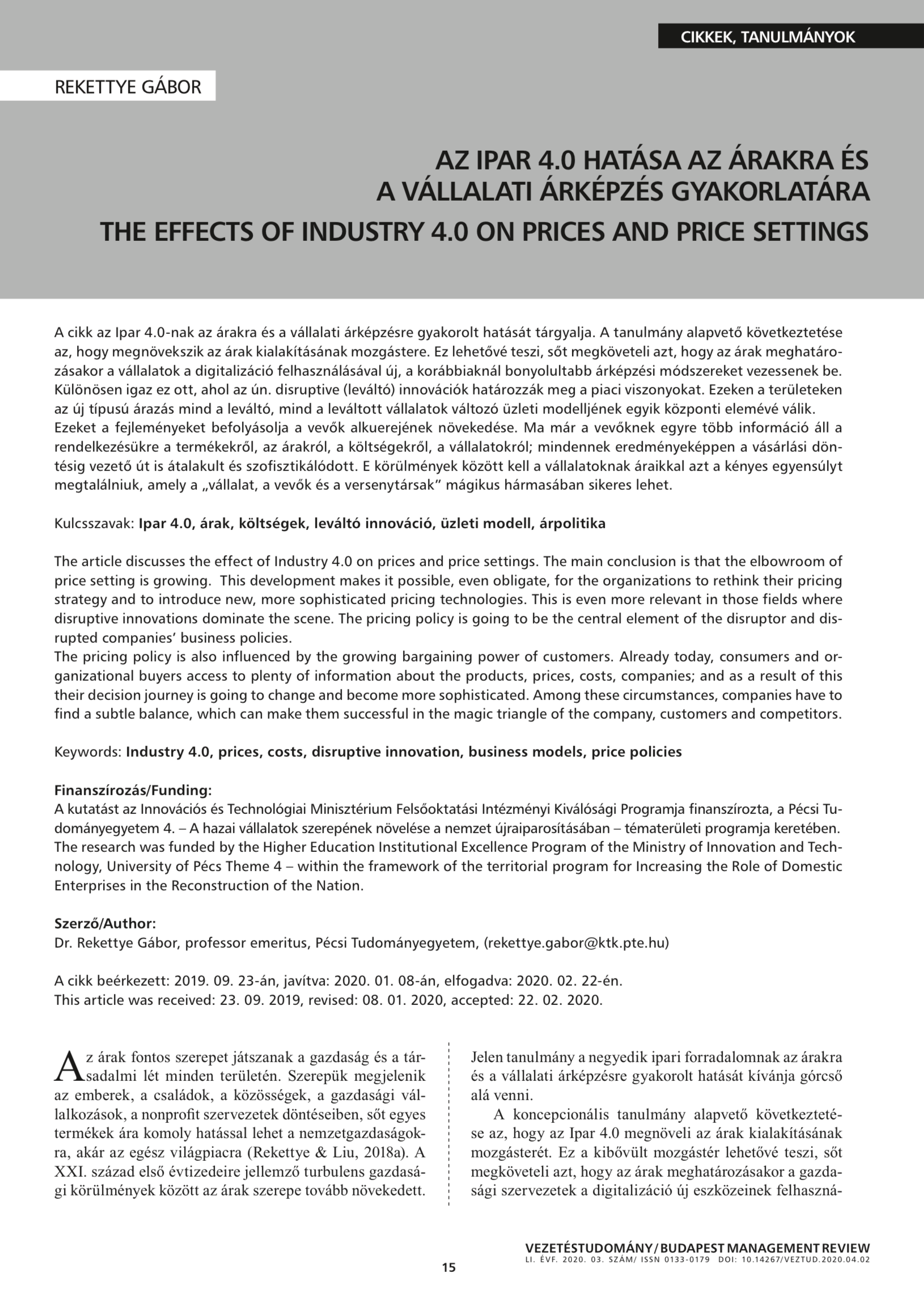Az ipar 4.0 hatása az árakra és a vállalati árképzés gyakorlatára
DOI:
https://doi.org/10.14267/VEZTUD.2020.04.02Kulcsszavak:
ipar 4.0, árak, költségek, leváltó innováció, üzleti modell, árpolitikaAbsztrakt
A cikk az Ipar 4.0-nak az árakra és a vállalati árképzésre gyakorolt hatását tárgyalja. A tanulmány alapvető következtetése az, hogy megnövekszik az árak kialakításának mozgástere. Ez lehetővé teszi, sőt megköveteli azt, hogy az árak meghatározásakor a vállalatok a digitalizáció felhasználásával új, a korábbiaknál bonyolultabb árképzési módszereket vezessenek be. Különösen igaz ez ott, ahol az ún. disruptive (leváltó) innovációk határozzák meg a piaci viszonyokat. Ezeken a területeken az új típusú árazás mind a leváltó, mind a leváltott vállalatok változó üzleti modelljének egyik központi elemévé válik. Ezeket a fejleményeket befolyásolja a vevők alkuerejének növekedése. Ma már a vevőknek egyre több információ áll a rendelkezésükre a termékekről, az árakról, a költségekről, a vállalatokról; mindennek eredményeképpen a vásárlási döntésig vezető út is átalakult és szofisztikálódott. E körülmények között kell a vállalatoknak áraikkal azt a kényes egyensúlyt megtalálniuk, amely a „vállalat, a vevők és a versenytársak” mágikus hármasában sikeres lehet.
Letöltések
Hivatkozások
Acquia (2018). Closing the Gap: Customer Experience Trends Report 2019. Retrieved from https://serve4impact.blog/2018/11/08/closing-the-cx-gap-customer-experience-trends-report-2019/
Ariely, D. (2014). Predictably irrational, revised and expanded edition: The hidden forces that shape our decisions. New York: Harper Perennial.
Ali, F., Amin, M. & Cobanoglu, C. (2016). An Integrated Model of Service Experience, Emotions, Satisfaction, and Price Acceptance: An Empirical Analysis in the Chinese Hospitality Industry. Journal of Hospitality Marketing & Management, 25(4), 449-475. https://doi.org/10.1080/19368623.2015.1019172
Baharí, N., Maniak, R., and Fernanrez, V. (2015). Ecosystem Business Model Design, X XIVe Conférence Internationale de Management Stratégique, Paris, June 2015, pp. 1-18.
Balasubramanian, S., Bhattacharya, S., and Krishnan, V. (2015). Pricing Information Goods: A Strategic Analysis of the Selling and Pay-per-use Mechanisms. Marketing Science, 34(2), 218-234. https://doi.org/10.2139/ssrn.1960895
Barakonyi K. (2008). Üzleti modellek. Vezetéstudomány, 39(5), 2-14.
Bradley, J., Loucks, J., Macaulay, J., Noronha, A., & Wade, M. (2015). New Path to Customer Value. Global Center for Digital Business Transformation. IMD. Retrieved from https://www.imd.org/contentassets/9cab2f024b8a4b058b3e662c781f3614/disruptive-business-models
Caudron, L., & Van Petergen, D. (2015). Digital Transformation: A model to master digital disruption. Duval Union Consulting, Retrieved from https://www.digitaltransformationbook.com/
Chandler Jr., A.D. (1990). Scale and Scope – The Dynamics of Industrial Capitalism. Cambridge, MA.: The Belknap Press of Harvard University Press.
Chang, W-L., & Yuan, S-T. (2007). An overview of information goods selling. International Journal of Electronic Business, 5 (3), 2 94-314. h ttps://doi.org/10.1504/IJEB.2007.014513
Danyi P. (2018). A mesterséges intelligencia alkalmazása az árazásban. Marketing és Menedzsment, 52(3-4), 5-18.
Danyi P. (2019). A mesterséges intelligencia árazásbeli alkalmazásának várható hatásai. Marketing és Menedzsment, 53(1), 17-31. (in press).
Danyi P., & Veres I. (2019). Modern árazás. Budapest: Budapesti Műszaki és Gazdaságtudományi Egyetem.
Elzen, B., Geels, F. W., & Green, K. (2004). System Innovation and the Transition to Sustainability – Theory, Evidence and Policy. Northampton, MA: Edward Elgar Publisher. https://doi.org/10.4337/9781845423421
Emmer, M. (2019). New Pricing Models for the Digital Era. Forbes Magazine, Jan. 22, Retrieved from https://www.flexdrive.com/news/new-pricing-models-forthe-digital-era/
Jullien, B., Reisinger, M., & Rey, P. (2019). Personalized Pricing and Brand Distribution (working paper). Toulouse School of Economics, No TSE – 995, March.
Freeman, C., & Pérez, C. (1988). Structural crises of adjustment: Business cycles and investment behaviour. In G. Dosi (Ed.), Technical Change and Economic Theory (pp. 38-66). London: Pinter Publishers. https://doi.org/10.1016/j.technovation.2006.05.002
Kalyanaram, G., & Little, J.D.C. (1994). An Empirical Analysis of Latitude of Price Acceptance in Consumer Package Goods. Journal of Consumer Research, 21(3), 408–418. https://doi.org/10.1086/209407
Kawasaki, G. (2015). The Art of Evangelism. Harvard Business Review. Retrieved from https://hbr.org/2015/05/the-art-of-evangelism
Khoo, D. (2014). How has the internet changed consumers over the past 10 years and how can marketers best adapt? Brandba.se, September 25, 2014. Retrieved from http://www.brandba.se/blog/2014/8/11/how-hasthe-internet-changed-consumers-over-the-past-10-years-and-how-can-marketers-best-adapt
Krämer, A., & Kalka, R. (2017). How digital disruption changes pricing strategies and price models. In Phantom Ex Machina (pp. 87-103). Wiesbaden: Springer. Retrieved from http://exeo-consulting.com/pdf/exeo_Disruption%20Changes%20Pricing%20Strategies%20Price%20Models_2016.pdf
Krugman, P. (2000). Reckonings; What Price Fairness? The New York Times, Oct. 4, 2000. Retrieved from https://www.nytimes.com/2000/10/04/opinion/reckonings-what-price-fairness.html
Kucuk S. U., & Krishnamurthy, S. (2007). An analysis of consumer power on the Internet. Technovation, 27(1–2), 47-56. https://doi.org/10.1016/j.technovation.2006.05.002
Lemon, K. N., & Verhoef, P.C. (2016). Understanding Customer Experience throughout the Customer Journey. Journal of Marketing, 80(6), 6 9-96. h ttps://doi.org/10.1509/jm.15.0420
Loucks, J., Macaulay, J., Noronha, A., & Wade, M. (2016). Digital Vortex. Lausanne: IMD.
Mohammed, R. (2018). The Good-Better-Best Approach to Pricing. Harvard Business Review, 96(9), 106-115.
Monostori, L. (2015). Cyber-physical production systems: roots from manufacturing science and technology. Automatisierungstechnik, 63(10), 766–776. https://doi.org/10.1515/auto-2015-0066
NICE in Contact (2018). 2018 Customer Experience (CX) Transformation Benchmark. Retrieved from: https://www.niceincontact.com/call-center-resource-finder/2018-cx-transformation-benchmark-study
Nikola, S. (2018). Volvo’s New Pitch: ‘Don’t Buy This Car’. Bloomberg Business Week, 2018, Dec. 11. Retrieved from: https://www.bloomberg.com/news/articles/2018-12-11/volvo-s-new-pitch-don-t-buy-this-car
Nuvolari, A. (2018). Understanding successive industrial revolutions: A “development block” approach. https://doi.org/10.1016/j.eist.2018.11.002
Phlips, L. (1981). The economics of price discrimination. Cambridge: Cambridge University Press.
Pigou, A. C. (1920). The Economics of Welfare. London: Macmillan and Co Ltd. Retrieved from http://oll.libertyfund.org/EBooks/Pigou_0316.pdf
Porter, M. E., & Heppelmann, J. E. (2014). How smart, connected products are transforming competition. Harvard Business Review, 92(11), 64–88.
Pranjić, G., & Rekettye, G. (2019). Interaction of the Social Media and Big Data in Reaching Marketing Success in the Era of the Fourth Industrial Revolution. International Journal of Business Performence Management, 20(3), 247–260. https://doi.org/10.1504/IJBPM.2019.102015
Radjou, N., & Prabhu, J. (2014). What Frugal Innovators Do. Harvard Business Review. Retrieved from https://hbr.org/2014/12/what-frugal-innovators-do
Rekettye G, & Liu, J. (2018a). Pricing – The New Frontier. London: Transnational Press.
Rekettye G. (2018). Értékteremtés 4.0 – Termékek és szolgáltatások vevőorientált tervezése, fejlesztése és menedzselése. Budapest: Akadémiai Kiadó.
Rekettye G. (2011). Multidimenzionális árazás. Budapest: Akadémiai Kiadó.
Rekettye G., & Liu, J. (2018b). The present state of the game ‘hide and seek’ in pricing. International Journal of Business Performance Management, 19(2), 158-168. https://doi.org/10.1504/IJBPM.2018.090687
Richardson, A. (2010). Understanding Customer Experience. Harvard Business Review. Retreived from https://hbr.org/2007/02/understanding-customer-experience
Rüβman, M., Lorenz, M., Gerbert, P., Waldner, M., Justus, J., Engel, P., & Harnisch, M. (2015). Industry 4.0. Boston Consulting Group, April 2015. Retrieved from: https://www.zvw.de/media.media.72e472fb-1698-4a15-8858-44351c8902f.original.pdf
Salesforce research (2018). State of the Connected Customers – Insights from 6700+ consumers and business buyers on the intersection of experience, technology, and trust. Retrieved from: https://www.salesforce.com/content/dam/web/en_us/www/documents/e-books/state-of-the-connected-customer-report-second-edition2018.pdf
Schäffer, D. (2018). A "megokosodott" fogyasztó mítosza. Élelmiszer Magazin, 11. Retrieved from: http://storeinsider.hu/gazdasag/cikk/a_fogyasztonak_egyre_fontosabb_az_elmeny#
Shapiro, C., & Varian, H.R. (1998). Versioning: The Smart Way to Sell Information. Harvard Business Review, 75(11), 106-119.
Steppe, R. (2017). Online price discrimination and personal data: A General Data Protection Regulation perspective. Computer Law & Security Review: The International Journal of Technology Law and Practice, 33(6), 768-785. https://doi.org/10.1016/j.clsr.2017.05.008
Strange, R., & Zucchella, A. (2017). Industry 4.0, global value chains and international business. Multinational Business Review, 25(3), 174-184. https://doi.org/10.1108/MBR-05-2017-0028
Szemerédi E. (2019). Autonóm járművek – biztonság, használat és észlelt hasznosság. Tér Gazdaság Ember, 7(1), 111-135.
Tao, F., Cheng, Y., Zhang, L., & Nee, A. Y. (2017). Advanced manufacturing systems: socialization characteristics and trends. Journal of Intelligent Manufacturing, 28(5), 1079-1094. https://doi.org/10.1007/s10845-015-1042-8
Törőcsik M. (2016). A fogyasztói magatartás új tendenciái. Vezetéstudomány, 47(Marketing-tudományi különszám),19-25.
Varian, H.R. (1995). Pricing Information Goods (working paper). University of Michigan, Retrieved from http://people.ischool.berkeley.edu/~hal/Papers/price-info-goods.pdf

Downloads
Megjelent
Hogyan kell idézni
Folyóirat szám
Rovat
License
Authors assign copyright to Vezetéstudomány / Budapest Management Review. Authors are responsible for permission to reproduce copyright material from other sources.

